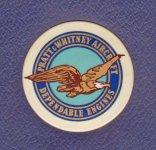...after all the well deserved discussion of the Merlin engine...I thought I would post this thread highlighting America's contribution to World War Two fighter plane engine technology...the Pratt and Whitney Double Wasp...
...what the Merlin did with engineering finesse...the Double Wasp did with the theory...more is better...more cylinders...18...more cubic inches...2800...and more horsepower...2000...evolving to 2400 by war's end in the Corsair...
...the Double Wasp was an eighteen cylinder (two rows of nine each)...air cooled...supercharged...radial engine...the air cooling was an advantage...as a well placed hit anywhere in the cooling system of the water cooled Merlin...Allison...or German DB 605...was a death blow...there are stories of the Double Wasp getting a pilot back home with entire cylinders shot off of the engine...
...the higher horsepower versions used in the Corsair swung a 13 foot 4 inch propellor...to put that in perspective...that propellor stood up on a basketball court...would extend four inches above the top of the backboard on the goal...that propellor is the reason for the dip in the Corsair's wings...to keep the landing gear to a manageable length and weight...and still keep the propellor off the ground when taxiing...taking off...and landing...
...the Double Wasp was also used in many other applications...both during and after the war...
...CLICK ON THE PHOTOS for full size...


...below are three excellent videos of the Double Wasp in action in the F4U Corsair flown by the Marine Corps...the P-47 Thunderbolt flown by the US army Air Corps...and the F6F Hellcat flown by the US Navy...click on the photos...



...what the Merlin did with engineering finesse...the Double Wasp did with the theory...more is better...more cylinders...18...more cubic inches...2800...and more horsepower...2000...evolving to 2400 by war's end in the Corsair...
...the Double Wasp was an eighteen cylinder (two rows of nine each)...air cooled...supercharged...radial engine...the air cooling was an advantage...as a well placed hit anywhere in the cooling system of the water cooled Merlin...Allison...or German DB 605...was a death blow...there are stories of the Double Wasp getting a pilot back home with entire cylinders shot off of the engine...
...the higher horsepower versions used in the Corsair swung a 13 foot 4 inch propellor...to put that in perspective...that propellor stood up on a basketball court...would extend four inches above the top of the backboard on the goal...that propellor is the reason for the dip in the Corsair's wings...to keep the landing gear to a manageable length and weight...and still keep the propellor off the ground when taxiing...taking off...and landing...
...the Double Wasp was also used in many other applications...both during and after the war...
...CLICK ON THE PHOTOS for full size...

...below are three excellent videos of the Double Wasp in action in the F4U Corsair flown by the Marine Corps...the P-47 Thunderbolt flown by the US army Air Corps...and the F6F Hellcat flown by the US Navy...click on the photos...










